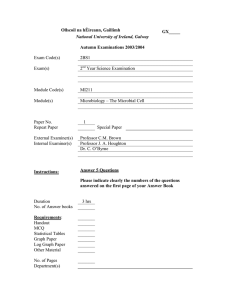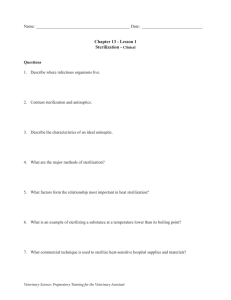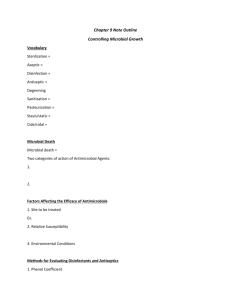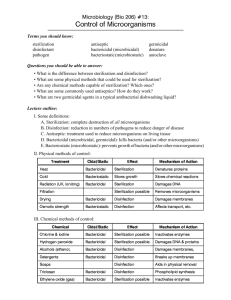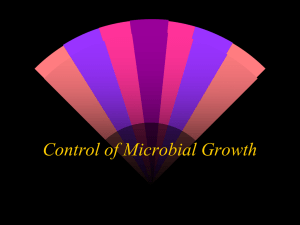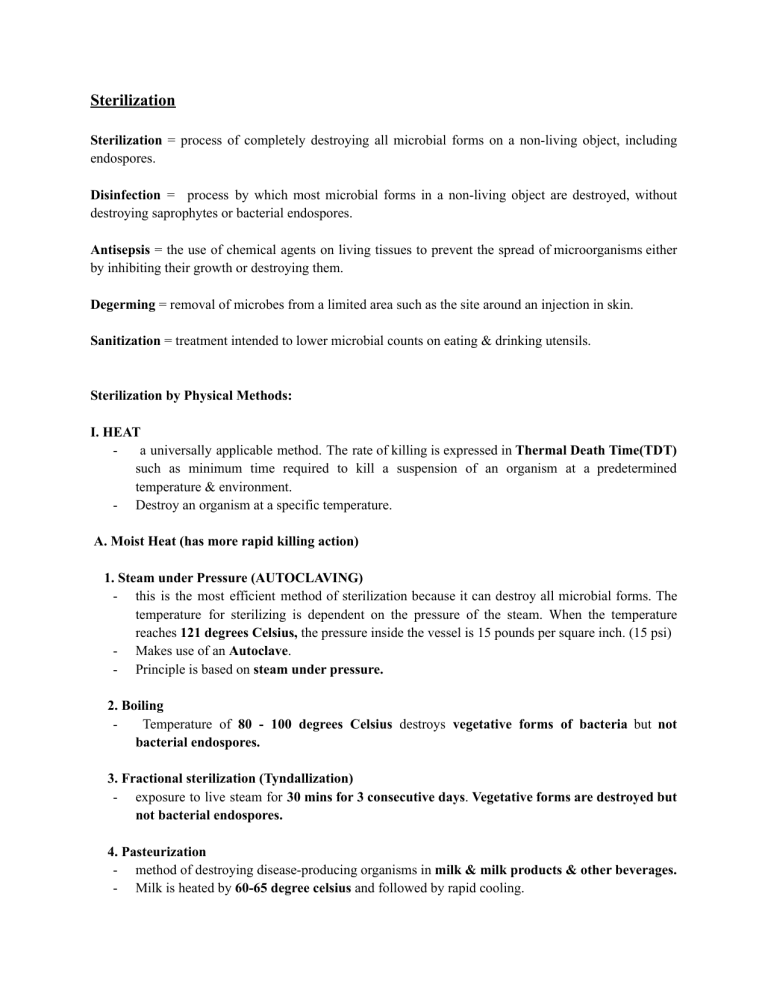
Sterilization Sterilization = process of completely destroying all microbial forms on a non-living object, including endospores. Disinfection = process by which most microbial forms in a non-living object are destroyed, without destroying saprophytes or bacterial endospores. Antisepsis = the use of chemical agents on living tissues to prevent the spread of microorganisms either by inhibiting their growth or destroying them. Degerming = removal of microbes from a limited area such as the site around an injection in skin. Sanitization = treatment intended to lower microbial counts on eating & drinking utensils. Sterilization by Physical Methods: I. HEAT a universally applicable method. The rate of killing is expressed in Thermal Death Time(TDT) such as minimum time required to kill a suspension of an organism at a predetermined temperature & environment. - Destroy an organism at a specific temperature. A. Moist Heat (has more rapid killing action) 1. Steam under Pressure (AUTOCLAVING) - this is the most efficient method of sterilization because it can destroy all microbial forms. The temperature for sterilizing is dependent on the pressure of the steam. When the temperature reaches 121 degrees Celsius, the pressure inside the vessel is 15 pounds per square inch. (15 psi) - Makes use of an Autoclave. - Principle is based on steam under pressure. 2. Boiling Temperature of 80 - 100 degrees Celsius destroys vegetative forms of bacteria but not bacterial endospores. 3. Fractional sterilization (Tyndallization) - exposure to live steam for 30 mins for 3 consecutive days. Vegetative forms are destroyed but not bacterial endospores. 4. Pasteurization - method of destroying disease-producing organisms in milk & milk products & other beverages. - Milk is heated by 60-65 degree celsius and followed by rapid cooling. II. DRY HEAT - effectiveness depends on the penetration of heat through the material. 1. Hot Air Oven = requires a higher temperature & longer period of exposure than moist heat. 2. Incineration = aimed at burning the organisms into ashes. 3. Open flame = same purpose as Incineration. 4. Desiccation = principle: to deprive the microorganism of moisture. 5. Freezing is not reliable because most pathogenic organisms are resistant to low temperatures. - Lyophilization( freeze-drying) = the organism is rapidly frozen, then dehydrated in high vacuum & stored in vacuum-sealed containers. 6. Filtration is a form of mechanical sieving. Microorganisms are not killed, but merely separated from the fluid. - Cellulose Ester Filter with 0.22 um pore size = can filter microorganisms except viruses & the 3 smallest bacteria: Mycoplasma, Rickettsia & Chlamydia. 7. Radiation 1. Ultraviolet Light (UVL) 240 - 280 nm. = is the most effective wavelength (optimum - 260 nm. - mechanism of action: disruption of the H-bonds in bacterial DNA, causing formation of thymine dimers in the DNA, which results in lethal frameshift mutations. - 2. Ionizing Radiation has greater penetrating ability than UVL. mechanism of action: formation of free radicals that will chemically interact with proteins & nucleic acid resulting in cell death. 8. Osmotic pressure Principle: based on osmosis, so when the concentration of the fluid surrounding the organism is altered, this will cause the bacterial cell to collapse. Chemical Methods of Sterilization: - Chemicals can inhibit the growth of pathogenic organisms, either temporarily or permanently. The following are factors which can affect the efficacy of a chemical agent: A. Concentration of the chemical agent B. Time C. Temperature D. Nature of the surrounding medium E. Nature of the organism
